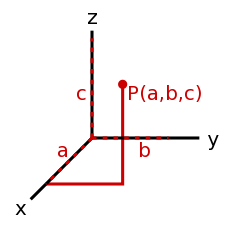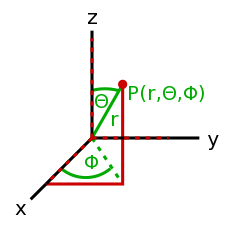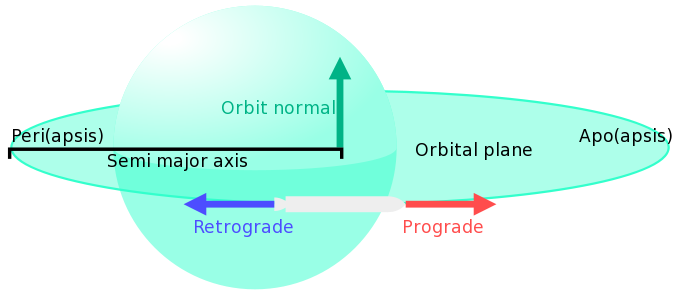Terminology/ja
From Kerbal Space Program Wiki
KSPには軌道や物理に関するたくさんの用語が登場するので素人には少々取っつきにくいところがあります。 また、一般的な用語の代わりに様々な科学用語や略語が使われていたりもします。
このページでは、重要な用語をリストアップし、簡潔に説明していきます。これであなたも一人前の宇宙飛行士!?
数学
- Elliptical/楕円
- 適当に飛ばしていたらほとんど周回軌道は、楕円軌道になる。
- Hyperbolic/双曲線
- 開いた滑らかな曲線。離脱軌道とかは双曲線になる。
- Normal vector/法線ベクトル
- 基準面に対して垂直なベクトル。
- Scalar/スカラー
- 方向を持たないただの値。普通、そのスカラーの次元が何なのかを示す単位が伴う。例えば3 m/sや、3 mや、3 sは、それぞれ速さ、距離、時間の単位が付いているが、方向がないのでスカラーである。
- Vector/ベクトル
- 方向と値がセットになったもの。例えば、方位(方向)と速さが一緒になったvelocity(速度)はベクトル。座標系が何であるか、何次元を考えるかによって、ベクトルの表され方は異なる。<35°, 12>は2次元の極座標ベクトル、<14, 9, -20>は3次元の直交座標ベクトルである。他にも座標系はあるが、この2つが一番よくつかわれる。
- <35°, 12> は、原点から35°(基準軸Xから反時計回りに大きくなる)の角度に向かって伸びる、長さ12の矢印である。(長さが0の場合、角度はない)
- <14, 9, -20> は、原点(<0,0,0>)から、X座標=14、Y座標=9、Z座標=-20の点に向かって伸びる矢印である。
- 直交座標を使う利点は、到着点がはっきり分かる点である。欠点は長さが分かりずらいことである。逆に、極座標は簡単に長さがわかるが、到着点がわかりずらい。
- velocity(速度), acceleration(加速度), force(力)はすべてベクトルである。
3次元座標系では
- 基準点。つまり出発点。
- 3つの基底ベクトル。軸の基本単位と、その方向を定義する。
- その座標系での位置を表す、角度か座標の3つのスカラー。
が必要である。
軌道
- Apoapsis/遠点
- Periapsis/近点
- Apsis/近点・遠点
- → 参照: “Apoapsis and periapsis” section in Orbit
- 楕円軌道には必ず2つのApsisが存在する。一つはperiapsis (q)といい、周回する天体に最も近い点(軌道の最低点)である。もう一つはapoapsis (Q)といい、periapsisの反対側にあり、天体から最も遠い点(軌道の最高点)である。天体との距離を計算する公式は普通、中心からの距離を考えているが、apsisは表面からの距離を考えているため、それに天体の半径を加算する必要がある。
- Peri~とApo~
- 軌道に関する話では、それが何の天体を周回する軌道かによって「periapsis」と「apoapsis」を少し変えて言う。例えば、Kerbinの周回軌道の場合は~keeや~kerbをつけて、Perikee/Perikerbと言ったりApokee/Apokerbと言ったりする。
- Ascending node/昇交点
- Descending node/降交点
- Orbital node/交点
- 基準面(赤道面や黄動面)と軌道面が交差する点。Ascending nodeは、軌道が北向きに交差する点。Descending nodeは、南向きに交差する点。
- Eccentricity/離心率
- → 参照: “Eccentricity” section in Orbit
- 軌道がどれだけ真円からかけ離れているかを表すスカラーである。
- ecc = 0 → 真円軌道
- 0 < ecc < 1 → 楕円軌道
- ecc = 1 → 放物線軌道(離脱軌道はこれ)
- ecc > 1 → 双曲線軌道(離脱軌道はこれ)
- Inclination/傾斜角
- → 参照: “Inclination” section in Orbit
- 軌道面と基準面の間の角度(例:赤道面に対しinclinationが90°の軌道は極軌道となる)
- Low orbit/低軌道
大気の空気抵抗などの影響を受けず、安定した軌道を保つのに必要最低限な高度の軌道のこと。低軌道は地表から最小の燃料で到達でき、離脱燃焼がどの方向にもできるので、上昇したあと次のランデブー目標(惑星や宇宙船)へ向かうまでの、踏み石として使われる。Kerbinの低軌道はおよそ80km~100kmである。大気のない天体では、理論上、地面より高ければどこでも軌道がとれるが、10km以下だと山や高地に激突する危険性が非常に高い。低軌道でのタイムワープは低く抑えられている。
- Orbital nodes
- ある軌道におけるApoapsis、Periapsis、他の軌道との交差点など、特定の基準点。
- Orbit normal
- 軌道平面の法線ベクトル。船の速度と重力の外積。右手の法則において中指を重力方向、人差し指を速度方向としたときの親指の方向がOrbital Normal。船が反時計回りに回っているときは、「Up」となり、時計回りに回っているときは「Down」となる。「Up」の代わりに「North」や「N+」と書くことがある。同様に「Down」を「Anti-Normal」「South」「N-」と書くことがある。
- Orbital plane/軌道平面
- 天体を回る軌道が描く仮想の円盤(inclinationを言う時に使われることが多い)
- Prograde/順行
- 船が軌道に沿って進んでいる方向。軌道はふつう楕円なので、常に、船がいる点における接線となる。
- Retrograde/逆行
- Progradeの反対方向。軌道に沿って後ろ向き。
- Reference plane/基準面
- 現在の軌道を記述するために基準とするあらゆる平面のこと。惑星を周回する軌道の場合、赤道面が基準面になる。太陽系において複数の天体がからむ場合、黄道面が基準面になる。他の物体をインターセプトする場合、その物体の軌道が基準面になる。基準面に対するinclinationとascending nodeの経度を知ることで、軌道平面を完全に記述することができる。
- Semi-major axis/軌道長半径
- → 参照: “Semi-major axis” section in Orbit
- 楕円の長軸をmajor-axisといい、sami-major axis(a)はその半径である。apoapsis (Q) とperiapsis (q)の平均から求まる。もちろん、これに天体の半径(R)を加算しなければならない。軌道長半径が同じ軌道は、離心率にかかわらず、必ず同じ周期になる。
- Sidereal period/恒星周期
- 恒星周期は、物体が恒星の周りを一周するのにかかる時間である。これは慣性系(非回転座標系)における公転周期である。
- Sub-orbital/弾道軌道
- periapsisが天体の表面よりも低い軌道のこと。つまり、そのまま進み続けると天体に衝突するような軌道。
- Synodic period/会合周期
- 会合周期とは、2つ以上の物体の関係において、ある物体が再び同じ位置に戻るまでにかかる時間。例えば、Kerbolから観測したとき、Kerbinに対してMunが再び同じ満ち欠けに見える位置に来るまでの時間。Kerbol-Kerbinラインを考えたとき、再びそのラインに交わるまでの時間と同じ。公転周期の一つだが、Kerbolを周回するKerbinから観測しているため、恒星周期とは異なる。
船の方向
- Zenith /天頂
- 船の天井側。通常、天体から離れていく方向。nadirの反対。
- Nadir /天底
- 船の床側。通常、天体に向かっていく方向。zenithの反対。
- Port(side) /左舷
- 船の左側。starboardの反対。
- Starboard /右舷
- 船の右側。port(side)の反対側。
- Front /前
- 船の前方。通常、ノーズやprogradeと同じ。aftの反対。
- Aft /後
- 船の後方。通常、船のエンジンがついている方向、retrogradeと同じ。frontの反対。
マニューバ
- Atmospheric braking /大気ブレーキ
- → メイン記事: Aerobraking
- periapsisを惑星の大気を通るように下げること。こうすることによって空気抵抗が船のスピードを低下させる。そのまま大気圏突入に繋げることもできるし、燃料を使わずに軌道を大きく変えることができる。空力ブレーキ、エアロブレーキングともいう。
- Lithobraking /地面ブレーキ
- → 参照: Lithobraking on Wikipedia
- 空気の代わりに地面を使って空力ブレーキを行うこと。要するに墜落したことを格好良く言っているだけ。エアロブレーキの「エアロ」をギリシャ語で岩や石を意味する「リトス」に替えたもの。本来はエアバッグなどを使って着地の衝撃を吸収しながら速度を下げる方法で、マーズ・パスファインダーの着陸法に採用された。
- Atmospheric entry/大気圏突入
- → メイン記事: Atmospheric entry
- 大気圏に突入し、空気抵抗などを使って減速することによって、地表に向かって降下する弾道軌道をとること。現実の世界では、大気から再び宇宙空間に戻ってしまわないようなスピードまで十分減速させることは、機体に激しい熱を発生させる。(0.24.2[outdated]) 現在、突入エフェクトは視覚的なものだけで、この熱は実装されていないが、パーツを過熱させるMODは作られている。通常「re-entry/reentry(再突入)」と言われるが、これはKerbinの大気に突入する場合にのみ当てはまるもので、単に突入という時は、より一般的な意味になる。
- Burn /燃焼
- エンジンを燃焼させること。通常、何らかのかたちで軌道を変えるために行われる。
- Circularizing /真円化
- 周回軌道の離心率を0かそれに近づけること。普通、apsisで燃焼することで行われる。
- Maneuver node /マニューバ・ノード
- → メイン記事: Maneuver node
- マップ・ビューにおいて予定したマニューバ。 燃焼の効果を前もって教えてくれる。
- Radial-in burn
- 天体の中心に向かって行われる燃焼。periapsisが天体の重心を通過するまで軌道を反時計回りに回転させる。radial-out burnの反対。
- Radial-out burn
- 天体の中心から離れる向きに行われる燃焼。periapsisが天体の重心を通過するまで軌道を時計回りに回転させる。
- Radial burn
- → 参照: Maneuver node
- Re-entry
- → 参照: Atmospheric entry
- Retroburn /逆噴射
- 「後ろ向き」に行われる燃焼。例えば、エンジンがprogradeを向いていて、ノーズがretrogradeを向いているときに燃焼すること。periapsisやapoapsisを下げるのに使われる一般的なマニューバである。
Physics
- Acceleration
- Rate of change to the velocity. Acceleration is a vector, measured in "m/s2".
- Ballistic trajectory
- A falling object's trajectory is ballistic. In rocketry it usually indicates that the object in question is only influenced by gravity and does not exert any force (ie. thrust) of its own.
- Delta-v (Δv)
- The change in velocity that has or can be exerted by the spacecraft. This is measured in meters per second (m/s). More mass can reduce the delta-v, while more propulsion can increase it. This makes it a useful value to calculate the effectiveness of launch vehicles. For example, a launch vehicle requires about 4,500 m/s of delta-v to escape Kerbin's atmosphere and achieve a stable orbit.
- Energy
- → 参照: Specific orbital energy on Wikipedia
- The energy of an object in an orbit is the sum of its potential and kinetic energy. The potential energy is and kinetic energy where G is the gravitational constant, M is the mass of the body, m is the mass of the craft, R is the distance from the center of the body and v is the velocity. This results in . This sum stays the same when not thrusting: When approaching periapsis potential energy is transferred into kinetic energy. After passing the periapsis the kinetic energy is converted back into potential energy. When the energy or specific orbital energy is greater than zero the vehicle is on an escape trajectory.
- This is the basic idea behind Kepler's laws of planetary motion, which is what gives rise to KSP's patched conics approximation. An ellipse is the set of all points on a plane such that the sum of the distances to two points - the foci - is some constant. One focus of a Kepler orbit is the centre of mass of the object being orbited; as an object approaches it, it exchanges potential energy for kinetic energy. As the object moves away from this focus - equivalently, if the orbit is elliptical, as the object approaches the other focus - it exchanges kinetic energy for potential energy. If the craft going directly towards or away from the object, the foci coincide with the apsides, where the kinetic (apoapsis) or potential (periapsis) energy is zero. If it's perfectly circular (e.g. the Mun's orbit around Kerbin), the two foci coincide and the locations of the apsides are undefined, since every point of the orbit is an apsis.
- There is also the specific orbital energy () which doesn't require the mass of the craft: , , . All orbits with the same semi-major axis (a) have the same specific orbital energy.
- Escape Velocity
- The velocity needed to escape a given planet's gravity well, as given by where G is the gravitational constant, M is the mass of the planet, and r is the radius of the planet.
- g-force (G)
- A measurement of acceleration as expressed in the sea-level force of Earth's gravity with 1 G being about 9.81 m/s². An object at Earth's surface is accelerated at 1 G. The object weighs twice as much when at 2 G acceleration and is weightless when accelerated with 0 G. In free fall, like in orbit, and without an engine running or an atmosphere applying drag all objects experience no acceleration which can be expressed as 0 G.
- Gravity
- The force exerted by all objects with mass. Very weak. Usually only objects with very high mass - ie. planets, moons - have any noticeable effect. Diminishes with the square of distance from the center of mass. So for an object twice as far, experiences only 1/22 = 1/4 of the gravity.
- Gravity Well
- The area around a planet affected by gravity. Actually extends to infinity, but as gravity decreases quadratically with distance (after twice the distance the gravity is only a quarter), it is only significant within the body's sphere of influence. In fact, in KSP, gravity isn't simulated at all beyond a body's sphere of influence due to its use of the "patched conic approximation".
- Orbit
- → メイン記事: Orbit
- When an object has sufficient tangential velocity (and is outside the atmosphere, so drag won't slow it down) so that it will keep falling "next" to the planet (never touching ground) its trajectory is called an orbit. Stable orbits are elliptical (a circle is an ellipse with zero eccentricity). If the objects tangential speed exceeds escape velocity it's orbit will be either para- or hyperbolic.
- Specific Impulse (Isp)
- → メイン記事: Specific impulse
- The Isp defines how effective a propulsion system is. The higher the Isp the more powerful is the thrust applied to the rocket with the same fuel mass. The Isp is usually given in seconds but actually the physically correct unit is distance per time which is usually given in meters per second or feet per second. To avoid confusion which unit of speed is used, the physical correct Isp (in distance/time) is divided by the surface gravity of Earth (9.81 m/s²). This results in a value given in seconds. To use this Isp in formulas it must to be converted back into distance per time which requires multiplying with the surface gravity of Earth again. As this value is only used to convert between those two units, the specific impulse doesn't change when the gravity changes. It appears that KSP use a value like 9.82 m/s² and thus using a little less fuel.
- As the specific impulse is the ratio of thrust and fuel flow is sometimes given as the unit. This is mathematically another form of because force is the multiplication of mass and acceleration defining . So with the latter being simply only in SI base units.
- Sphere of influence
- → メイン記事: Sphere of influence
- The radius around a celestial body within which its gravity well is non-negligible. Commonly known as SoI/SOI.
- Tangential velocity
- The component of the velocity that is tangential to the trajectory. Instantaneous velocity - velocity when the time of measurement approaches zero - is always tangential to the trajectory.
- Thrust-to-weight ratio
- → 参照: Thrust-to-weight ratio
- The Ratio between the total mass of the vehicle and the available thrust of all propulsion devices of the vehicle/current stage. A TWR greater than 1 means the craft will have enough thrust to accelerate vertically and gain altitude. A TWR below 1 means that the craft won't be able to counteract gravity and drag at low altitudes, although in space it only means that maneuvers will take longer. Because the weight (W) depends on the current gravitational acceleration (g) the TWR depends on which body is currently influencing the craft. The acceleration on the Mun's surface is only 16.6 % of Kerbin's acceleration, so at the surface a TWRKerbin = 1 would be a TWRMun = 6.
- Trajectory
- A trajectory is the path that a moving object follows through space as a function of time.
- Velocity
- Rate of change of the position. It is the combination of speed with the direction. Velocity is a vector, measured in meters per second (m/s).













![I_{{sp}}={\frac {T}{{\dot m}}},[I_{{sp}}]={\frac {m}{s}}](https://en.wikipedia.org/api/rest_v1/media/math/render/svg/7ff940eef93d9743a07d72ba2bb808e3b0372c36)




